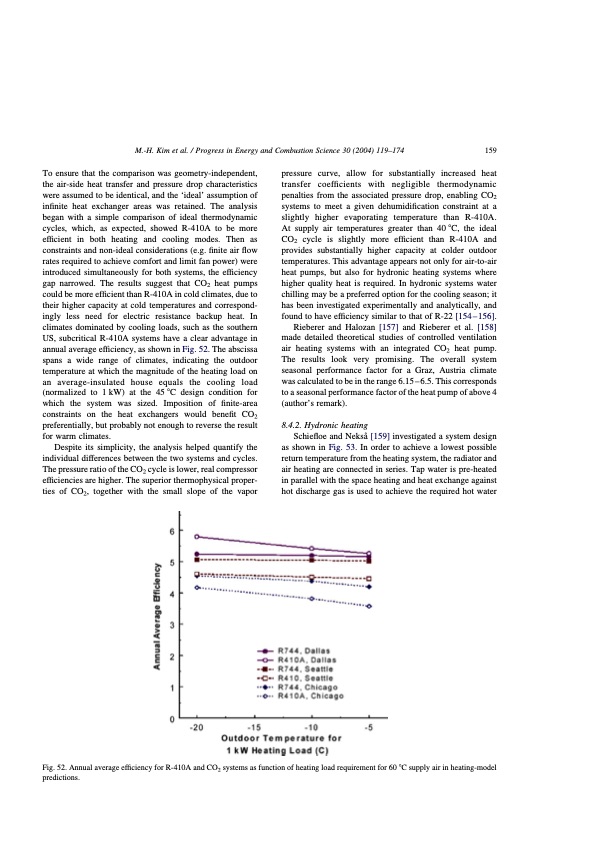
PDF Publication Title:
Text from PDF Page: 041
M.-H. Kim et al. / Progress in Energy and Combustion Science 30 (2004) 119–174 159 To ensure that the comparison was geometry-independent, the air-side heat transfer and pressure drop characteristics were assumed to be identical, and the ‘ideal’ assumption of infinite heat exchanger areas was retained. The analysis began with a simple comparison of ideal thermodynamic cycles, which, as expected, showed R-410A to be more efficient in both heating and cooling modes. Then as constraints and non-ideal considerations (e.g. finite air flow rates required to achieve comfort and limit fan power) were introduced simultaneously for both systems, the efficiency gap narrowed. The results suggest that CO2 heat pumps could be more efficient than R-410A in cold climates, due to their higher capacity at cold temperatures and correspond- ingly less need for electric resistance backup heat. In climates dominated by cooling loads, such as the southern US, subcritical R-410A systems have a clear advantage in annual average efficiency, as shown in Fig. 52. The abscissa spans a wide range of climates, indicating the outdoor temperature at which the magnitude of the heating load on an average-insulated house equals the cooling load (normalized to 1 kW) at the 45 8C design condition for which the system was sized. Imposition of finite-area constraints on the heat exchangers would benefit CO2 preferentially, but probably not enough to reverse the result for warm climates. Despite its simplicity, the analysis helped quantify the individual differences between the two systems and cycles. The pressure ratio of the CO2 cycle is lower, real compressor efficiencies are higher. The superior thermophysical proper- ties of CO2, together with the small slope of the vapor pressure curve, allow for substantially increased heat transfer coefficients with negligible thermodynamic penalties from the associated pressure drop, enabling CO2 systems to meet a given dehumidification constraint at a slightly higher evaporating temperature than R-410A. At supply air temperatures greater than 40 8C, the ideal CO2 cycle is slightly more efficient than R-410A and provides substantially higher capacity at colder outdoor temperatures. This advantage appears not only for air-to-air heat pumps, but also for hydronic heating systems where higher quality heat is required. In hydronic systems water chilling may be a preferred option for the cooling season; it has been investigated experimentally and analytically, and found to have efficiency similar to that of R-22 [154 – 156]. Rieberer and Halozan [157] and Rieberer et al. [158] made detailed theoretical studies of controlled ventilation air heating systems with an integrated CO2 heat pump. The results look very promising. The overall system seasonal performance factor for a Graz, Austria climate was calculated to be in the range 6.15 – 6.5. This corresponds to a seasonal performance factor of the heat pump of above 4 (author’s remark). 8.4.2. Hydronic heating Schiefloe and Neksa ̊ [159] investigated a system design as shown in Fig. 53. In order to achieve a lowest possible return temperature from the heating system, the radiator and air heating are connected in series. Tap water is pre-heated in parallel with the space heating and heat exchange against hot discharge gas is used to achieve the required hot water Fig. 52. Annual average efficiency for R-410A and CO2 systems as function of heating load requirement for 60 8C supply air in heating-model predictions.PDF Image | CO2 Vapor Compression Systems

PDF Search Title:
CO2 Vapor Compression SystemsOriginal File Name Searched:
co2-vapor-compression-systems.pdfDIY PDF Search: Google It | Yahoo | Bing
CO2 Organic Rankine Cycle Experimenter Platform The supercritical CO2 phase change system is both a heat pump and organic rankine cycle which can be used for those purposes and as a supercritical extractor for advanced subcritical and supercritical extraction technology. Uses include producing nanoparticles, precious metal CO2 extraction, lithium battery recycling, and other applications... More Info
Heat Pumps CO2 ORC Heat Pump System Platform More Info
| CONTACT TEL: 608-238-6001 Email: greg@infinityturbine.com | RSS | AMP |